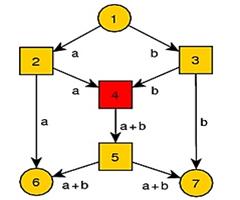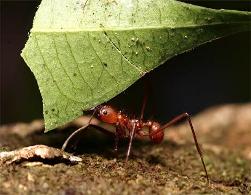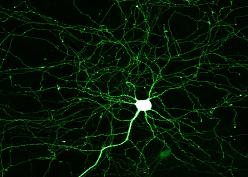
|
Research |
|
During my graduate period, I have worked on providing Quality of Service (QoS) using network coding. In this process, we have proposed a new algorithm that guarantees specified QoS parameters, namely end-to-end delay and rate, with minimum possible cost.
Since our algorithm is based on optimization algorithms, during my |
|
Relevant publications |
|
QoS Network Coding |

|
research I have worked a lot on optimization techniques. In fact, most of my work is dedicated to optimization methods that minimize a convex network cost regarding delay and rate constraints. I have shown via simulations that while our algorithm is able to guarantee QoS, its total cost is not much higher than the minimum cost yielded by minimum cost multicast approaches.
Currently I am working on extending my work to model more practical networks. In addition, I am going to do a through comparison between the suggested approach and the equivalent methods in that uses routing instead of network coding to show the advantages of network coding over routing in providing QoS.
|
|
· Amir Hesam Salavati, Babak Hosein Khalaj, Pedro M. Crespo, Mohammad Reza Aref, “QoS Network Coding”, To appear: Proc. 2008 International Symposium on Information Theory and its Applications (ISITA2008), Auckland, Newzland (Download PDF) · Amir Hesam Salavati, Babak Hosein Khalaj, Mohammad Reza Aref, “A Novel Approach for Providing QoS with Network Coding”, Proc. International Symposium on Telecommunications (IST 2008), August 2008, Tehran, Iran (Download PDF) · Amir Hesam Salavati, Babak Hosein Khalaj, Pedro M. Crespo, Mohammad Reza Aref, “Wireless QoSNC: A Novel Approach to QoS-based Network Coding in Wireless Networks”, Submitted to IEEE Journal on Selected areas in Communication (JSAC) special issue on network coding for wireless communication networks (Download PDF) · Amir Hesam Salavati, Babak Hosein Khalaj, Pedro M. Crespo, Mohammad Reza Aref, “QoSNC: A Novel Approach to QoS-based Network Coding for Fixed Networks”, Submitted to Journal of Communications and Networks (JCN) special issue on network coding (Download PDF) |
|
People |
|
Information Systems and Security Lab (ISSL) Plus some good papers on: |
|
Useful Links |
|
Bioinformatics is an inter-disciplinary field which involves molecular biology, computational techniques and mathematics. In a nutshell, bioinformatics first conceptualizes biology in terms of molecules. Then model these molecules with a sequence and apply computational techniques to this sequence. Due to its computational/mathematics nature, bioinformatics deals very much with electrical and computer engineering. |
|
Bioinformatics |
|
About two year ago, one of my friends (Mr. Masih Nilchian) and I formed a small group to work on applications of information theory in bioinformatics. We did a thorough literature review in this area to find out that although there are many possible avenues for using information theory in bioinformatics, current works are only limited to the very basic features of information theory, namely mutual information and entropy.
We are working on extending the applications of information theory in bioinformatics to design new algorithms for gene detection, finding coding and non-coding regions and so on. To do that, we have found it very useful to extend the applications of information theory in linguistics to bioinformatics. There are many information theory-based algorithms in linguistics to analyze statistical properties of natural languages.
There is an ever-growing evidence that genome/protein sequences have almost the same properties as the sequence of alphabets in a natural language. So it seems rational to model genome/protein as a book written in some unknown language. This is what we are currently doing. We’d like to first show that this assumption is compatible with experimental pieces of evidence and then extend current information theory-based algorithms in linguistics to analyze genome/protein.
|
|
· Amir Hesam Salavai, Masih Nilchian, “Applications of Information Theory in Bioinformatics”, Technical report, Electrical Engineering Department, Sharif U. of Tech., Jun. 2007 (Download PDF) (in Persian) · Masih Nilchian, Amir Hesam Salavai, “Applications of Information Theory in Linguistics and Its Extension to Bioinformatics”, Technical report, Electrical Engineering Department, Sharif U. of Tech., Feb. 2008 (Download PDF) (in Persian) |
|
Dr. Mohammad Reza Aref, ISSL director Dr. Mehdi Sadeghi, IPM bioinformatics research group director Masih Nilchian, MSc Student, Communication systems, Sharif U. of Tech. (Masih is one of my best friends. He and I formed the bioinformatics subgroup in ISSL) Kaveh Kavousi, PhD student, Machine intelligence and robotics, U. of Tehran Saeed Bagheri, BSc student, Electrical engineering, Sharif U. of Tech. Mahnoush Alizadeh, BSc student, Electrical engineering, Sharif U. of Tech. |
|
Relevant publications |
|
People |
|
Useful Links |

|
Relevant publications |
|
Recently, a number of approaches inspired by biological mechanisms and phenomena have been proposed as a strategy to handle the complexity of massively distributed systems such as the Internet, or wireless ad hoc and sensor networks. The goal of bio-inspired approaches is to discover and to adapt biological methods to technical solutions that are showing similarly high stability, adaptability, and scalability, as biological entities often have(+). |
|
Bio-inspired Algorithms in Communication Networks |
|
Together with some of my colleagues, I am working on incorporating bio-inspired ideas in communication network algorithms. We first did a literature review on bio-inspired routing algorithms, including bee, termite and ant-based routing method. Then we focused on ant-based.
Currently, we are working on applications of ant-based approaches in peer to peer networks, especially media streaming P2P networks. We have designed an algorithm for rate allocation in media streaming networks which is based on foraging behavior of ants. We are extending this algorithm to do the search process in P2P networks as well. |
|
· Amir Hesam Salavati, Hadi Goudarzi, Mohammad Reza Pakravan, “An Ant Based Rate Allocation Algorithm For Media Streaming in Peer to Peer Networks”, To appear: Proc. Local Computer Networks (LCN) 2008, Oct. 2008, Montreal, Canada (Download PDF) · Hadi Goudarzi, Amir Hesam Salavati, Mohammad Reza Pakravan, “An Ant Based Algorithm For Media Streaming over Peer to Peer Networks”, To be submitted to IEEE Journal on Selected areas in Communication (JSAC) special issue on bio-inspired networking. · Amir Hesam Salavai, Seyyed Pouya Shariat Panahi, “Bio-inspired Routing in Wireless Networks”, Technical report, Advanced data networks final project report, Electrical Engineering Department, Sharif U. of Tech., Jun. 2007 (Download PDF) (in Persian) |
|
Dr. Mohammad Reza Pakravan, Group supervisor Hadi Goudarzi, MSc Student, Communication systems, Sharif U. of Tech. (Hadi is one of my best friends. It’s been a while that he and I are working on this subject) Pouya Shariat Panahi, MSc Student, Communication systems, Sharif U. of Tech. (Pouya is also one of my best friends. Pouya and I first formed this group to do the research assignment of advanced data networks)
|
|
People |
|
Useful Links |

|
Myelinated nerve fibers’ conduction behavior is very similar to that of a transmission line. In both cases, an electromagnetic wave propagates through the medium in accordance with Maxwell’s equations. In some disorders, such as multiple sclerosis, myelin is damaged and as a result, conduction along the nerve fiber is blocked. |
|
Conduction Block Analysis in Myelinated Nerve Fibers |
|
We have modeled nerve as a set of cascaded, short transmission lines to investigate conduction block in demyelinated nerve fibers using analytical methods. According to the preliminary results, demyelination will increase the attenuation coefficient of nerve fibers. Consequently, much of the wave power is wasted due to high loss factor of the nerve. This will cause the conduction block in the fiber. |
|
Dr. Shahriar Gharibzadeh, group advisor Masih Nilchian, MSc Student, Communication systems, Sharif U. of Tech. |
|
Relevant publications |
|
People |
|
Useful Links |

|
· Amir Hesam Salavati, Masih Nilchian, Shahriar Gharibzadeh, “Analyzing Conduction Block in Multiple Sclerosis Using Transmission Line Theory”, To be submitted to Journal of Theoretical Biology (JTB)
|
|
Sensor networks are a sensing, computing and communication infrastructure that allows us to instrument, observe, and respond to phenomena in the natural environment, and in our physical and cyber infrastructure (1). In my spare time I’ve done some research on WSNs. We had once had a research group on WSNs in our department. Recently, some of my friends and I have formed a group to work on commercial aspects |
|
Sensor Networks |
|
of sensor networks specially in home and vehicular sections. We also have submitted a sample business plan to the business plan contest held by the Sharif University of Technology’s center of entrepreneurship.
|
|
Masih Nilchian, MSc Student, Communication systems, Sharif U. of Tech. Rouhollah Farhang, MSc Student, Communication systems, Sharif U. of Tech. |
|
People |
|
Entrepreneurship Center of Sharif University of Technology’s And some good papers on: |
|
Useful Links |


|
Home | Biography | CV | Research | Publications | A Place for Sharing Knowledge | Photo Gallery | Contacts |
|
Almost all multi-constrained QoS routing problems are NP-Complete. More specifically, QoS routing problems with more than one additive, multiplicative or a mixture of both, are NP-Complete. In addition, even some seemingly easy problems in routing domain |
|
Network Coding & NP-Complete QoS Routing Problems |
|
are NP-complete as well. Finding minimum cost multicast trees, or better known as finding Steiner trees, is one of such problems.
However, Lun et. al.[+] has shown that the similar problem in network coding domain could be solved in polynomial time by using linear programming methods.
Since our QoSNC algorithm is basically very similar to the approach used by Lun et. al., we are working on extending our algorithm to show that it is able to solve QoS network coding equivalent problems of NP-Complete QoS routing ones, in polynomial time. |
|
Dr. Babak Hosein Khalaj, Sharif University of Technology Dr. Mohammad Reza Aref, Sharif University of Technology Ehsan Varaiani, B.Sc. Student, Sharif University of Technology |
|
People |
|
Information Systems and Security Lab (ISSL) Plus some good papers on: |
|
Useful Links |
